Karijini National Park: Everything You Need To Know
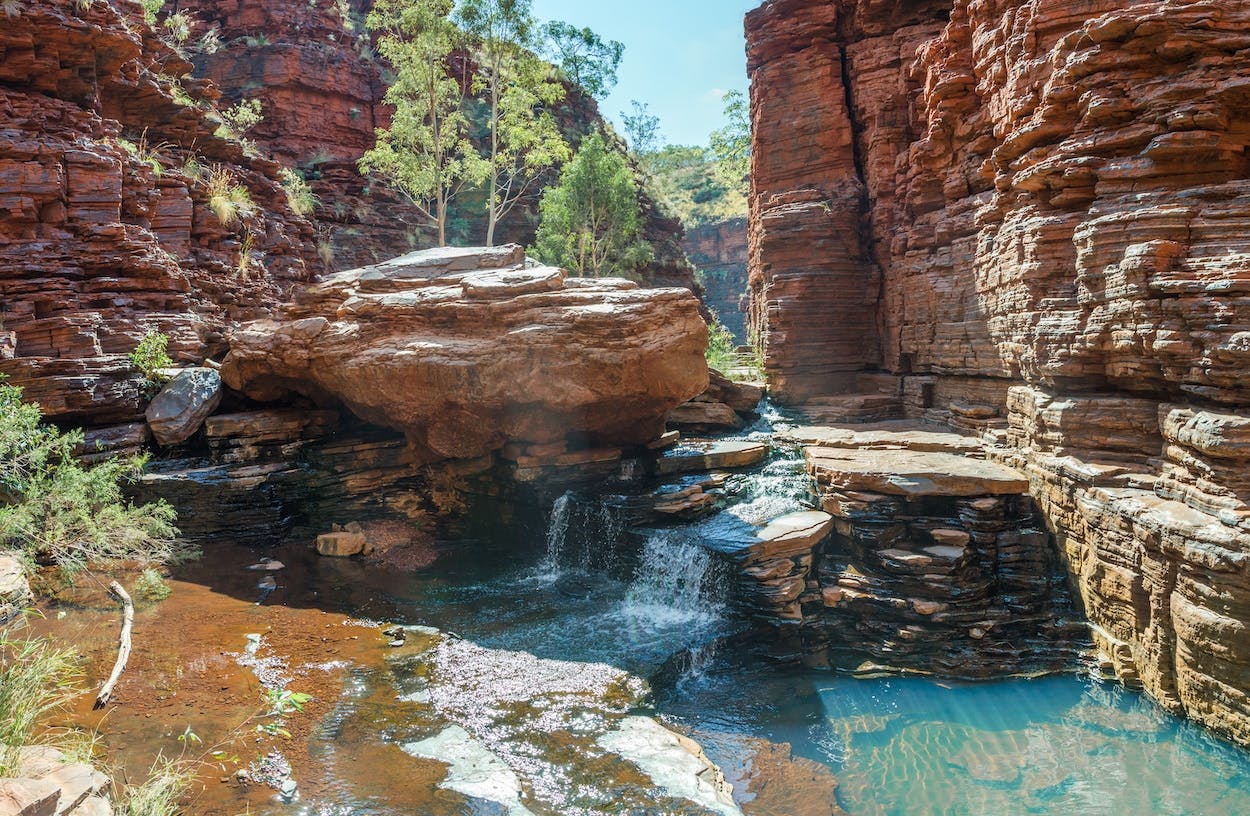
Regarded as one of the best National Parks in WA (if not, in our somewhat biased opinion, all of Australia!), Karijini National Park is an incredible spot to explore and the perfect place to head for a road trip up north. An adventure lover’s dream, the park is packed with spectacular places to hike and swim.
What is it?
Karijini is home to a number of outstanding gorges to explore – imagine crystal clear pools of water at the base of deep iron-rich red coloured gorges and picturesque waterfalls all set amongst an ancient landscape. The rock formations in the park are over two billion years old, making Karijini home to some of the oldest rock formations in Australia and the world!
Where is it?
Located in the Pilbara, Karijini is about a 14 hour drive from Perth (about 1400 km) via Meekatharra and Newman along the Great Northern Highway. Otherwise, you can use the coastal road via Exmouth and check out fab places along the way like Kalbarri, Monkey Mia, Shark Bay and Coral Bay. If you’re not up for a road trip, there are flights to nearby towns of Paraburdoo and Newman. Karijini is then about a 140km drive from Paraburdoo or 185 kms from Newman. Check here for our guide to a Coral Coast Highway Road Trip.
What to do?
Karijini is an adventure lover’s paradise! The park is home to challenging Grade 5 hikes but the reward is breathtaking views into the heart of gorges, incredible waterfalls and fab swimming spots:
Hancock Gorge:
The Grade 5 walk into Hancock Gorge is often described as ‘journeying into the centre of the earth’ and it isn’t hard to see why – the rock formations in this ancient gorge are 2.5 billion years old! Descend into Hancock Gorge down a series of ladders and make your way along narrow, slippery rock ledges or wade through icy cold pools of water to get to a beautiful natural amphitheatre. To continue on and get to the aptly named Kermit’s Pool you’ll need to ‘spider-walk’ (using all four limbs to inch your way along a narrow section of the gorge) to get to a deep, green coloured plunge pool at the end of the trail.
Weano Gorge:
In Weano Gorge wade through waist-high water, scramble over rocks and boulders, clamber through a narrow section of the iron-ore rich red gorge to emerge at the top of a waterfall where you can climb down using a handrail for a swim amongst the towering red gorge walls in the plunge pool below.
Dales Gorge:
Get your fix of fresh water swimming in the crystal clear waters of Fortescue Falls in Dales Gorge and Fern Pool (Jubura). After clambering down the metal staircase you’ll first come along the cascading Fortescue Falls. You can keep climbing down for a refreshing swim at the base of the falls or continue on down the trail to the spectacular Fern Pool (Jubara). This perfect little fern lined turquoise pool and spring-fed waterfall is a significant place to the local Aboriginal people and visitors are asked to be quiet and respectful while there. Also located in Dales Gorge is Circular Pool but this spot is currently closed due to rockfalls in the area.
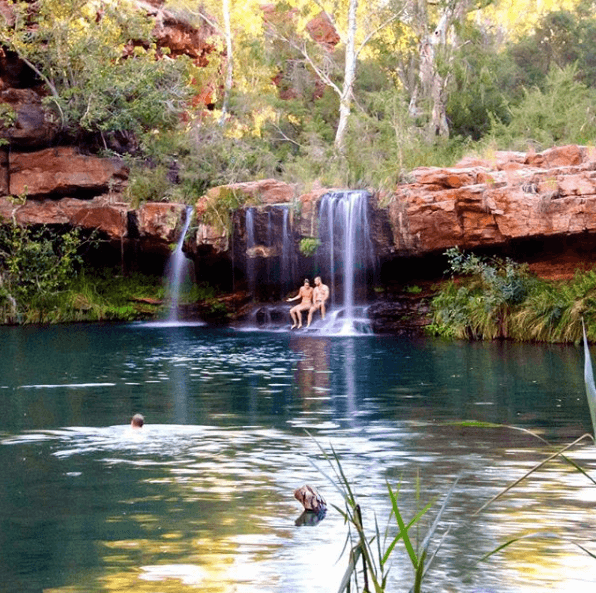
Fern Pool, in Dales Gorge
Hamersley Gorge
One of the most picturesque and photographed spots in the park is Spa Pool, located in Hamersley Gorge. To get to this perfect little pool it’s a bit of a detour from the other gorges to head out to the north-west side of Karijini, but it’s well worth the effort! Keep an eye out for the spectacular banded rock formations while you hike or swim through the gorge and enjoy soaking up those views while floating away in this beautiful spot.
Knox Gorge:
Check out the great views from the lookout then follow the trail down into the gorge. Shuffle along rock ledges and scramble over rocks as you make your way through the gorge to get to the incredible slot canyon at the end of the trail.
Kalamina Gorge:
Kalamina is one of the quieter gorges in the National Park, and you’ll often be lucky enough to have this place to yourself. Make your way down the set of stone steps and once at the bottom turn right to get to the small waterfall at the base of the gorge. Wander downstream through the relatively shallow gorge system to see ‘nature’s window’ at the end of the gorge.
Joffre Gorge:
One of the more challenging trails in the park. You can check out the great views from the observation platform near the car park, or to get to the base of this fab spot, head across the top of the falls and then tackle a steep, but short, climb down the rocky edge to the base of the gorge. Turn right and follow the stream to get to the beautiful curved waterfall that cascades down the natural amphitheatre-like gorge.
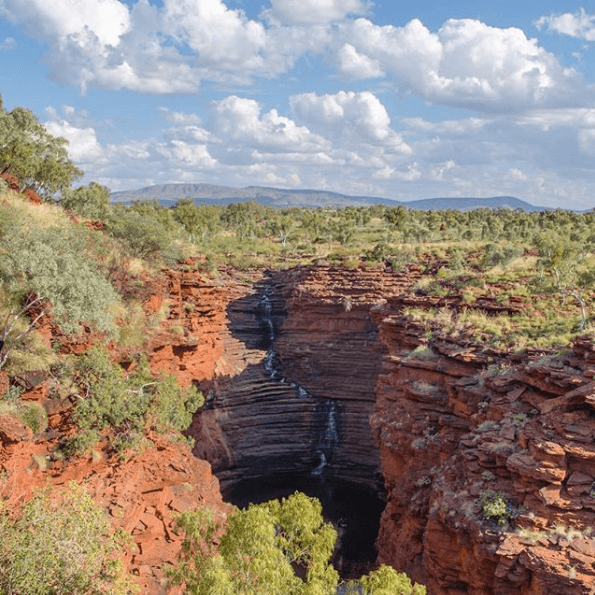
Joffre Gorge
Punurrunha (Mt Bruce):
Mount Bruce (Punurrunha) is located on the western outskirts of Karijini and if you’re headed from Tom Price you’ll spot it easily on your way into the park. At 1,234 meters, it’s the second highest peak in Western Australia and you can hike to the summit to enjoy the stunning views across the Pilbara landscape. The 10 km, Grade 5 hike can be challenging and takes up to 4-6 hours return depending on your fitness level.
There are also a number of great lookouts in the park offering epic birds-eye views down into the deep gorges. Make sure you pop into the Karijini Visitor Centre which is not only a great spot to learn about the geology, culture and history of the area but also the staff there can answer any questions you might have.
Where to stay:
Karijini Eco Retreat
Karijini Eco Retreat is an ecologically friendly and environmentally aware retreat, located in the Pilbara region. It offers eco tents, cabins and campsites nestled amongst native bushland at the edge of Joffre Gorge, along with an outback style restaurant and access to the park’s walks and guided adventure tours.
The retreat uses solar power and all floors are made from recycled timber. Each deluxe eco tent has limited lights and are naturally ventilated. Karijini Eco Retreat is owned by Gumala Enterprises Pty Ltd, the business arm of the Gumala Aboriginal Corporation, which is one of Australia’s largest 100% Traditionally Owned organisations, serving the Banjima, Yinhawangka and Nyiyaparli people of the Pilbara region in WA.
You’ll also find the unpowered Savannah Campground at Karijini Eco Retreat. The campground has shared bathroom facilities including flushing toilets and solar hot water showers as well as BBQ facilities. You can book online here.
Dales Gorge Campground
Dales Campground is close to Dales Gorge on the eastern side of the park, where you’ll find nearby Fortescue Falls and Fern Pool. The unpowered campground, operated by Parks and Wildlife service, has only very basic facilities but a number of toilets are located throughout the campground. Generators are only allowed at Cockatoo and Bungarra Loops. You can book online here.
Overflow campground
Located near the Visitor’s centre (about 1 km away), the overflow campground is only available in peak season and there is a two night maximum stay (you’ll need to book in to the other campgrounds after that). You can book online here.
All campground bookings must be made online, with bookings available up to 180 days in advance.
What not to do:
While Karijini is filled with adventure, it’s also packed with plenty of risks: from snake bites, falls, and heat exhaustion to injuries from rock ledges collapsing and even death. The gorges have steep steps, high narrow ledges you need to inch your way across, smooth rock surfaces that can become super slippery when wet and high vertical drops. While the high rock ledges might seem stable, they can give way without warning and shouldn’t be climbed, and roped off areas and restricted areas in the park are there to keep you safe (and alive).
As recently as April 2021 a tourist died after falling in one of the gorges. This is one of those places that you really do need to listen to the warnings and restrictions. Rescues here take hours and it’s not just for your safety but also for the safety of the rescue team. Back in 2004, SES Volunteer James Regan died in a flash flood while attempting to rescue an injured hiker. Medical evacuations from Hancock Gorge, where many of the accidents in the park occur, may take up to eight hours. Be sensible, don’t take risks or do anything stupid – and stay alive!
And make sure you come prepared: There are limited supplies within the park so stock up on food, water and fuel before you leave or at neighbouring towns like Tom Price. There aren’t any petrol stations in Karijini so you’ll need to make sure you carry enough fuel for your adventures within the park; the closest places to Karijini for fuel are Auski Roadhouse and Tom Price.
Like any outback trip, pack and carry plenty of water with you. It’s also worth packing sturdy shoes with plenty of grip and a dry bag is always handy to keep your gear dry in the gorges.
The water in the gorges can be icy cold, especially in winter. Pack plenty of warm clothes for the cold winter nights as overnight temperatures can drop to zero degrees! On the other hand, it can get extremely hot in the gorges in Summer and there’s also a high risk of flash flooding in wet weather. Please leave the gorges if it starts raining.
Anything else?
Yes, lots! The Banjima, Yinhawangka and Kurrama people are the traditional owners and custodians of the park. The best way to explore the entire park is with a 4WD. The road into Karijini, as well as to the visitor centre, Dales Gorge and all but the last 3kms to the Eco Retreat from the western entrance is sealed and easily accessible.
There’s a daily park entry fee per vehicle if you don’t have a Parks pass (available from here). If you’re planning on staying for a few days it’s worth checking out the holiday pass rather than buying multiple daily passes.
The best time to visit is between April and October. During these months the day time temperatures are warm with cold nights; perfect for hiking and swimming. Keep an eye out for stunning flowers that bloom during the Pilbara’s wildflower season between June to September. Try to avoid the summer months between November and March as daytime temperatures at Karijini can get extremely hot and you’ll also have the added risk of heavy rains.
There’s a range of walks you can do in the park which range from Grade 2 (Suitable for beginners, young children; tracks might be rough or have steps or short, steep sections) to Grade 5 (recommended for very experienced hikers on trails over rough or steep terrain with limited/no track markers). The trails in Weano, Hancock and Knox Gorges all end in roped off restricted Grade 6 areas. Unfortunately, canyoning and abseiling tours to explore these restricted Grade 6 areas are no longer frequently run, but keen adventurers can book in for an adrenaline packed tour with Spacechameleon Adventure Co. who run a very limited amount of tours in April and September.
There’s limited mobile coverage within Karijini but you can find Optus coverage around the Visitor Centre, Karijini Eco Retreat and Dales Campground and intermittent Telstra coverage in some areas of the park.
The Karijini Experience is held every April and celebrates culture, music, food and art. There are a number of free and ticketed events which in the past have included guided walks, art classes and workshops, yoga in the gorge, astronomy and photography classes. The dates for 2022’s Karijini Experience are 13-17 April and tickets will be on sale in early 2022.
Photos:
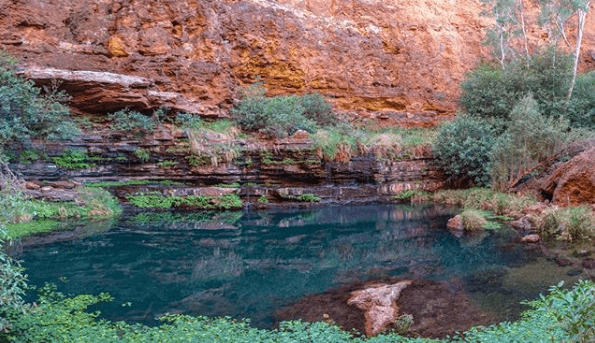
First light, Circular Pool
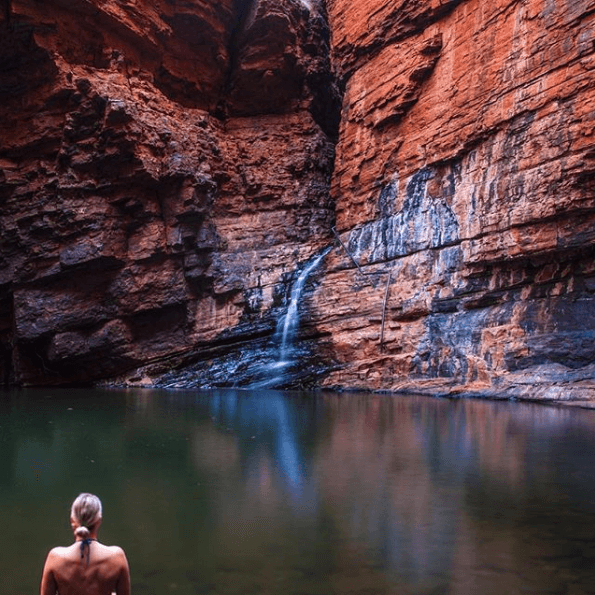
Handrail Pool
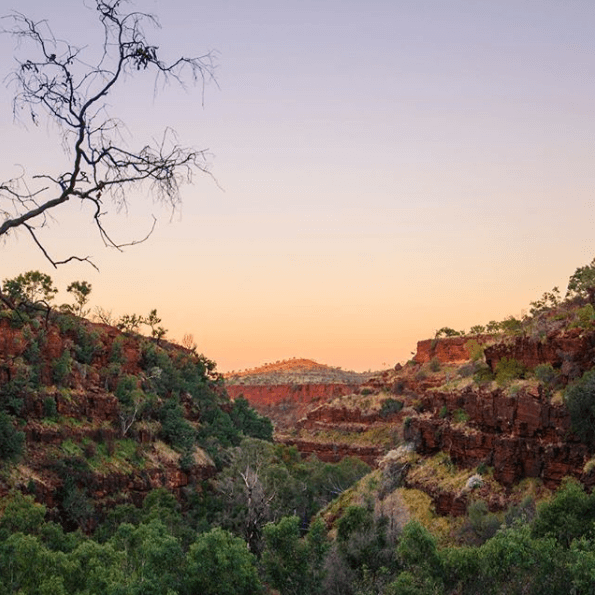
Dales Gorge
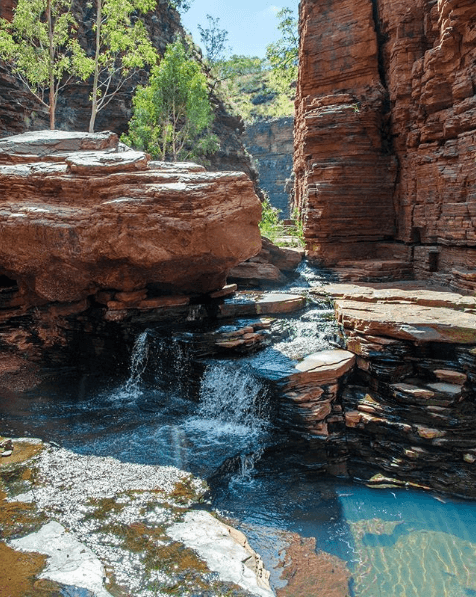
Hancock Gorge
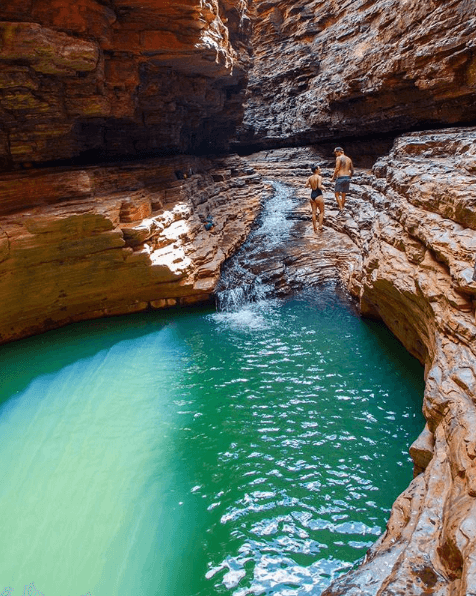
Kermits Pool, Hancock Gorge
All research, words & photos by our North-West correspondent @alex.vp.photography.